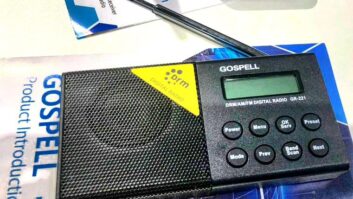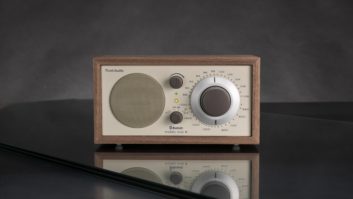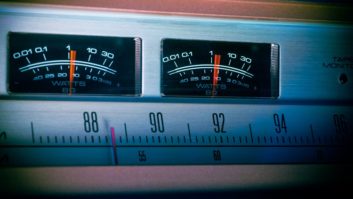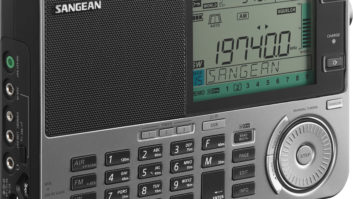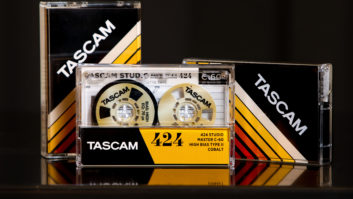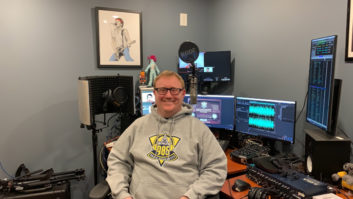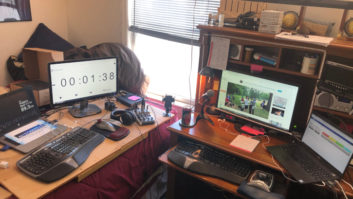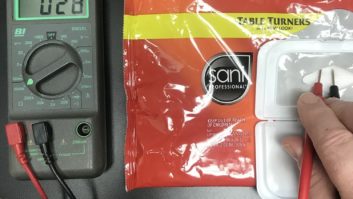Truly portable radio
Feb 1, 2002 12:00 PM, By Chriss Scherer, editor
Don’t be burdened with too much equipment. Travel light and stay flexible for the best sounding remotes possible.
Any time a station broadcasts from outside the studio, whether it’s a promotional appearance, sporting event, news coverage or sponsored appearance, the term “remote” is used to describe it. While these events are unique in their own way, the same basic plan can make each a success.
Quality audio is the primary goal of any remote broadcast. The bottom line determines the level of resources, both financial and manpower, that can be dedicated to remotes, but even in the most restrictive of circumstances, a small investment can yield a substantial gain. The key to planning your station’s remote broadcast toolbox is to keep it portable and compact, while maintaining flexibility.
The tools available for remotes, while not drastically changing, are seeing advances and improvements in areas such as the extension of audio link frequency response, data path provision, simplification of operations, and the addition of layers of flexibility to handle new situations.
More with less
Like most areas of business, remote broadcasts are pushing to do more with fewer resources, whether those resources are equipment or people. Providing simpler methods of setting up and running a remote allows the engineering staff to focus on bigger projects.
Remote pickup transmitters are one of the more common methods of establishing a remote link. Because RF usage is increasing, some markets are forced to work with fellow broadcasters or find alternate methods to establish a link. One area of RPU improvement is the introduction of frequency-agile transmitters and receivers. In areas of RF congestion, or for users working in more than one market, the ability to easily change frequencies can help clear the way with a clearer path.
Moseley has developed an enhancement for RPU users with a digital RF link. The Aries 400S provides a 64kb/s to 128kb/s data path through a V.35 interface. Many popular codecs can provide a V.35 output, and an optional Layer II I/O is available.
Any time RF channels are used, proper frequency coordination should be done. The Society of Broadcast Engineers has operated a volunteer coordination program for many years. Contact the SBE (www.sbe.org) for the name of the coordinator in your area before using any RF equipment, particularly if you are working in a different market.
Hold the phone
The telephone is probably the most common way to establish an audio link, particularly on short notice. Using the telephone by itself works, but even a simple coupler can greatly improve the audio response. With the proliferation of cell phones, the same convenience is made even easier, but typically with even less audio quality. Again, there are couplers and adapters to simplify audio and improve integration into a cell phone.
Integrated equipment functions make for smoother event setups.

While cell phones are easy to use, they typically provide poor to good audio quality, depending on the system and type of service (see sidebar). One alternative to using interfaces and adapters with cell phones is the Digital Cellcast from Marti.
The Digital Cellcast combines a cell phone and portable mixer into one package. The unit works with TDMA dual-mode, TDMA tri-mode and GSM, but not CDMA services. The transmitted audio uses the cell network; no external audio encoding/decoding is done. Users contact a cellular service provider and supplies the unit’s serial number. The provider then supplies a telephone number and system identifier for the user to program into the unit.
ISDN codecs redefined the way stations establish high-quality links with telephone company-provided lines. The higher data capacity of digital phone lines lends itself well to remote use. Codec manufacturers have also improved on their original designs by reducing the size of the equipment and adding additional features, such as audio mixers and multiple monitoring buses.
Not long after ISDN codecs were introduced, POTS codecs hit the scene. The attraction to using POTS lines is that it is very easy to locate an extra POTS line in a facility, whereas most ISDN line need to be ordered in advance. POTS codecs work well for last-minute remotes or situations where the budget cannot support the cost of ISDN service.
Codecs have quickly evolved into highly versatile devices.

Like their ISDN cousins, POTS codecs have also seen improvements with enhanced mixers and better-sounding, more robust encoding algorithms. The quest to achieve higher audio quality via a POTS line is also pushing the line for using codecs with cell phones.
This idea brings together the best of both worlds: the true portability of a cell phone with the enriched quality of an audio codec. Currently, only GSM service is capable of a real-time data transfer. Audio does not travel well through a packet data service. Also, other cell services use various forms of data compression, which are not compatible with the already aggressive coding used on the audio.
GSM service currently is only available in larger metro areas as shown in Figure 1. It is expected that GSM coverage will continue to increase, allowing for greater opportunities to use cell phones and codecs. The best quality available with a codec and GSM service is currently about 5kHz.
In Europe, where GSM service has been available for some time, a high-speed version of GSM, called HSCSD, is available. Services such as this may become available as third-generation cell phone networks come into being.
Simplifying the methods
Another way to reduce the equipment load is with a dual-personality codec. These codecs give can function with both POTS and ISDN lines by selecting the appropriate modem. These are well-suited for news reporters and sports remotes where the connection may vary on location. The dual-function hardware reduces the equipment load.
Figure 1. GSM service coverage in North America.

With the reduction in station operation staffs, some stations need a way to run the station from the remote site. Some codecs provide a data path for a low-speed serial connection. These paths are commonly used to provide data between the station and remote site, or allow the remote site to directly control a telephone system, automation system or other station equipment.
Running the console remotely is possible with current designs based on audio engines. Logitek is even adding a motorized fader option to its NuMix controllers to provide visual feedback to the station operator.
Remotely accessing the station’s automation system allows the remote site to upload audio for on-air playback. An example is SmartTouch, a component of the Smarts Broadcast SmartCaster. The automation system can be controlled and audio can be uploaded through the same telephone line or through a separate communications link. The remote site can also switch his feed directly to air if necessary.
In some applications, it may be necessary to use a POTS codec in an unmanned mode, for example, during a weekly church service broadcast. The station can call into the unit at the church when necessary. TieLine has taken this one step further with its Pursuit POTS codec, which has no user controls on it. The audio connections are made and the levels are then controlled locally by a PC or over the POTS line by an Express or Commander model codec.
Remote radio broadcasts are a staple of a station’s routine, providing a personal interaction between station and listener. In most cases, the only image a listener has of a station is what he sees at a remote. Sound quality is important for the listener not attending the remote. Reliable, easy-to-operate equipment completes the image for the attending listener. By using some of the current tools, your remotes can sound better than ever.
Types of cellular serviceFDMA:
frequency division multiple access
Used on all analog cellular systems. FDMA splits the allocated spectrum into 30kHz channels. A single channel is used for each call.TDMA:
time division multiple access
TDMA builds on FDMA by dividing conversations by frequency and time. Digital compression squeezes the audio to about 10kb/s, fitting three digital conversations into a single FDMA channel. This is compatible with FDMA while enabling digital services.
TDMA does not vary the digital data rates. The time slot is occupied by the call regardless of use. TDMA transmit about 600mW.CDMA:
code division multiple access
CDMA systems do not have channels, but instead encodes each call as a coded sequence across the entire frequency spectrum. Each conversation is digitally modulated with a unique code (called a pseudo-noise code) that makes it distinguishable from the other calls in the frequency spectrum. The spread spectrum approach places the data across 1.25MHz pass bands within the 12.5MHz (cellular) or 60MHz (PCS) spectrum.
CDMA offers three times the capacity of TDMA, but requires complex deciphering and extracting the received signals. CDMA phones transmit about 200mW.GSM:
Global System for Mobile Communications
Mostly a European system, but it is gaining popularity in North America. GSM uses a modified, more efficient version of TDMA. GSM keeps the idea of timeslots and frequency channels, but uses smaller timeslots. Data rates start at 300b/s. Calls use as many time slots as necessary up to a maximum usage of 13kb/s. Calls will jump between channels and timeslots (frequency hopping) to maximize the system’s usage. GSM phones transmit about 1W.
Remotes To Go
By Chriss Scherer, editor
Not the same old broadcast van
You see them all the time: standard panel vans with a telescoping mast and a few assorted pieces of RF and audio equipment. These remote workhorses are customized for the types of remotes a given stations performs. Some are heavily equipped for any possible situation, while others are basic shells with an RPU transmitter and a microphone. Basic setups may have only one power source available, but in more elaborate situations, any number of power sources, including a portable generator or the vehicle’s alternator, drive the van’s complement of equipment.
In most cases, the type of vehicle is chosen solely on its purchase or lease price. There are times when a more unique vehicle can offer more than just the necessary storage space and hauling capability. A particular vehicle may be chosen because it fits the station’s image � a pickup truck with a shell for a country music station � or it provides something that a traditional panel van cannot.
Here are four examples of stations that broke the mold on the selection of their remote vehicle along with some notes on why the particular choice was made.
KALC-FM, Denver
This ambulance was converted into a remote vehicle and then later rebuilt by Creative Studio Solutions. The spacious interior has plenty of room for station staff to work and conduct interviews. The body style also provides lots of storage space and multiple entry points.

Radio Noord, Amsterdam, The Netherlands
The other vehicles mentioned here are based on larger-than-usual body styles. This is a move in the opposite direction. The small Mercedes Benz A-Class is little more than 12 feet long. One of the rear passenger seats has been removed to make room for an for an equipment rack. While this particular vehicle is not available in North America, it shows that a small vehicle can be used for remotes.
Photo courtesy of Broadcast Technical Projects BV.

WOOF-FM, Dothan, AL
This box-style delivery van has lots of interior space. The usual broadcast equipment is installed. Aside from the large space for the station’s logo, the vehicle also provides a dressing room for the station’s mascot, the WOOF Wolf. The rear roll-up door also provides easy access.
Photo by Hal Edwards.

WIOT-FM, Toledo, OH
When a local distributor retired the vehicle, the stations purchased it.
The scrolling doors provide easy access to the vehicle’s generator, Marti RPU receiver and transmitter and PA equipment. Because of the vehicle’s size, it makes a very large presence at remote sites. The vehicle’s driver must hold a commercial driver’s license. Photo by Denny Moon.






